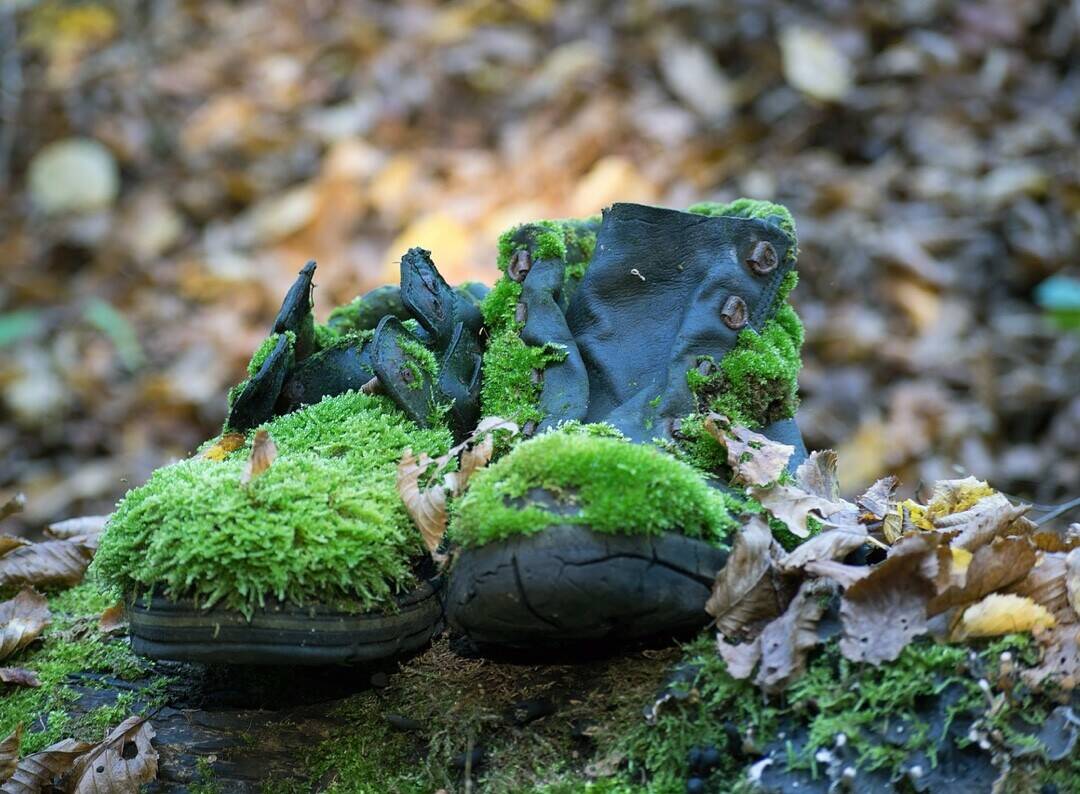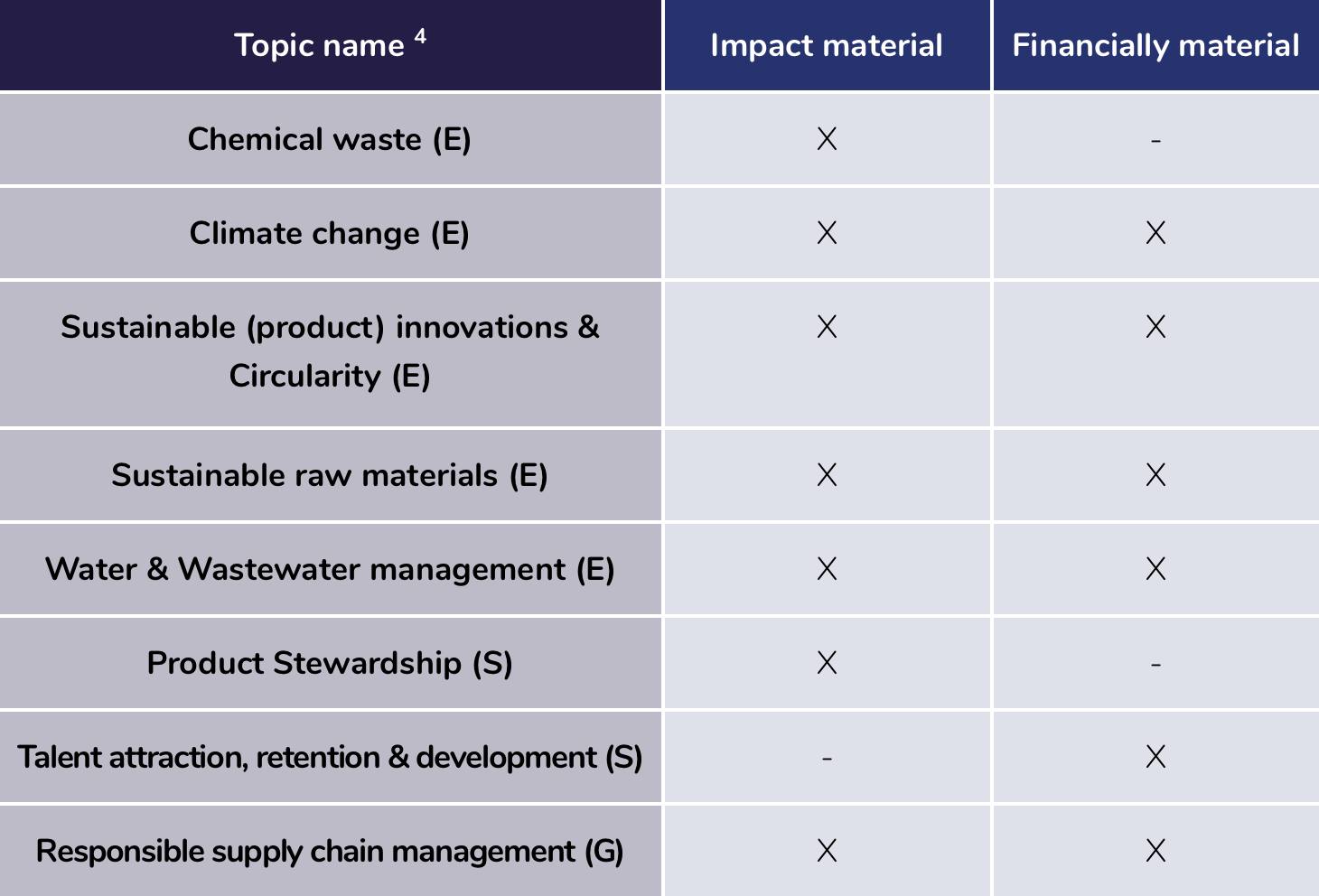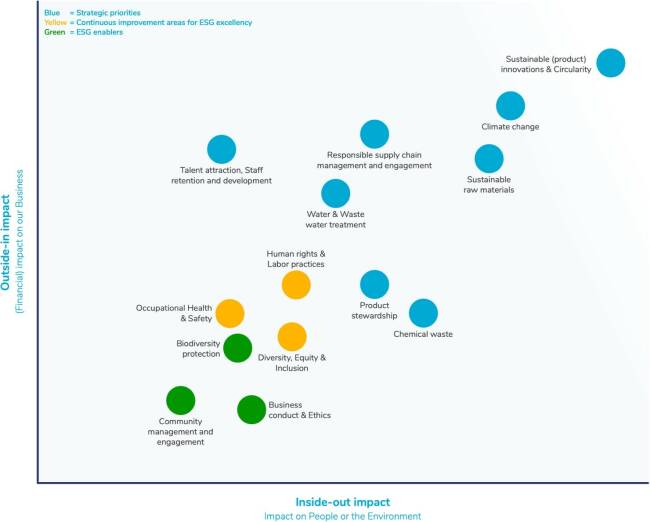ESG Landscape
As a company, we are committed to creating a socially and environmentally sustainable leather value chain, together with our stakeholders and putting sustainability at the heart of what we do. All the elements that add up to our ESG report can be aggregated and condensed into this one motto: Creating Sustainable Leather Together. We strongly believe that taking responsibility for the future of leather is the only way to create a business that is successful for the company and its shareholders, for the industry, for our employees, for our customers, and for society. Adherence to major international standards and principles and acting on our most material impacts, risks and opportunities shape our ESG landscape and are fundamental to our strategy and ESG approach.
We keep the United Nations’ 17 Sustainable Development Goals (UN SDGs) and the universal declaration of human rights close to our business decisions, and we have voluntarily joined the standards and principles of societal institutes like the International Labor Organization (ILO), ZDHC, LWG, Leather Naturally, SLF, TEGEWA, MVO Nederland, EcoVadis, and ISO. We respect international laws and regulations, specific customer requirements, the Declaration on Fundamental Principles and Rights of Work, and the Ethical Trading Initiative base code. We use the GRI Standards as the reporting guideline whenever we can and until the Corporate Sustainability Reporting Directive (CSRD) will be in force for disclosures related to 2025. Our ESG Policy lays out the principles that guide us in everything we do to help us achieve our mission.
While our commitment extends to all 17 UN Sustainable Development Goals (SDGs), we have identified five SDGs that are at the heart of our company’s strategy and to which we make a tangible contribution. These five goals not only guide our actions, but also serve as key drivers in our efforts to contribute to the rest of the SDGs as well. Throughout this report we highlight the specific SDGs’ addressed in each section, providing our contributions to sustainable development in a transparent way.
Five UN SDG goals

The leather industry is consuming and emitting large amounts of water, that’s why we encourage and support leather manufacturers to reduce water consumption and improve water quality. This goal can be reached by reducing pollution, minimizing the release of hazardous chemicals, increasing water recycling, safe reuse of water, and reduction of water consumption.


Leather is produced globally in countries with a wide variety of economic and societal circumstances. The leather industry has the potential to employ large amounts of people and thus increase prosperity for nations and all the people involved. We support this by introducing innovative technologies & processes that will provide decent work conditions and a good social environment. Training and education to work safely with chemicals are essential to this development.

















Circularity is the principle that drives our Research & Development and our procurement practices. This helps us to create a product portfolio that is mainly built from renewable resources, developed to have the least possible adverse impacts on human health and the environment (meeting or exceeding industry standards), optimizes resource efficiency in both the production process and in leather making, and will support creating a responsible end-of-life for leather. We collaborate with our stakeholders and industry partners to encourage the adoption of sustainable practices throughout our value chain and the leather industry.

Climate change is affecting every country on every continent. It is disrupting national economies and the food system we depend on and is affecting lives. Weather patterns are changing, sea levels are rising, and weather events are becoming more extreme. This is why we will keep on focusing on reducing the greenhouse gas emissions in our own premises, positively influencing these in our value chain, offsetting where necessary our footprint and ensure our products are developed to have the least possible impact on the environment.



We firmly believe in the ‘Power of Partnerships’, understanding that meaningful impact is best achieved through collaborations. Therefore, we support leading leather industry organizations to speed up the process creating a socially and environmentally sustainable leather value chain. Moreover, we proactively collaborate with all our stakeholders, sharing our knowledge, expertise and technology.


Double Materiality Assessment
Identifying and prioritising our material ESG topics.
Strategic priorities (material topics)
Topics that are at the heart of Royal Smit & Zoon activities and essential to build long-term value, contribute to the Company’s mission to create a sustainable leather value chain together with its stakeholders, and maintain a competitive edge in line with societal megatrends.Continuous improvement areas for ESG excellency
Topics on which efforts should be maintained for continuous improvement and ESG excellency.Sustainability enablers
Topics that put the Company in the right position to address the core focus areas.
2 Definition on the 14 ESG topics we eventually identified and classified into the three categories (explained by paragraph below), is available in the Appendices.
3 258 employees (91% of invitees), 26 sales partners, 15 suppliers and 9 service providers, participated in an online survey. In-depth interviews were held with our shareholders, a bank, 16 customers (across the globe), 3 industry associations, 1 educational institution and 1 NGO.
4 Material E, S and G topics in alphabetical order

The final results of our Double Materiality Assessment were approved by our ESG Steering Committee in September 2023. At the same time, we consider it a continuous improvement journey and will review our material topics and their impact annually. For now, the above 8 topics, and associated impacts, risks and opportunities, will be subject to future CSRD reporting requirements and accompanying European Sustainability Reporting Standards (ESRS).
The results of this double materiality assessment confirm the areas of focus in our current ESG Roadmap 2025 and will be used as key foundation in defining our strategic ESG priorities going forward into an enhanced ESG Strategy towards 2030. The assessment's insights will also help understand our material impacts, risks and opportunities. Focusing on these strategic priorities allows for maintaining our leadership in ESG practices. It is essential for Royal Smit & Zoon to align and integrate our ESG Strategy with our Company Strategy. This strategic focus will not only reflect our commitment but also bring value to the Company and society in the long term
The materiality assessment was well received by the external stakeholders who were invited for interviews and surveys. We are extremely grateful for all their input on ESG related impacts, risks and opportunities for Royal Smit & Zoon, strategic direction, potential improvement points and interest for further collaboration. Understanding the perspectives and needs of our stakeholders enables us to understand what is important to them. By focusing our energy on those material topics, we are able to operate a successful business while creating a sustainable leather value chain. Now and for the generations to come.
In the Appendices, you will find more detailed reporting on stakeholder engagement activities and impacts, risks and opportunities per material topic.
The infographic below captures the 14 topics identified and shows the impact of a topic on people or the environment (horizontal axis) and on our business (vertical axis).
We determined 8 material topics and prioritized associated impacts, risks and opportunities:
As a start, we (re)identified our key internal and external stakeholder groups across our value chain, geographies, activities, business lines and relationships to Royal Smit & Zoon, and with diverse perspectives, to engage in the different phases of the assessment. As a basis for our assessment, we then collected a wide range of sustainability topics through extensive desk research on ESG reporting frameworks, benchmarks, standards, (trend) reports and publications, a selection of Royal Smit & Zoon’s peers, customers as well as our current initiatives. More than 100 impacts, risks and opportunities were identified, resulting in a list of 19 potential material topics. A clear definition, including scope and (value chain) boundaries, was created for each material topic and is available in the appendices of this report. 2
To understand stakeholder perspectives, a total of 333 stakeholders were consulted through interviews and online surveys 3. We engaged 7 external leather industry experts, carefully selected to represent our diverse stakeholder groups and provide comprehensive value chain perspectives. Conducting in-depth interviews with them, we gathered insights on impact perspective and scored impact materiality. Within the Company, 11 management professionals were engaged, spanning various disciplines, business lines and geographic regions. These internal experts participated in an extensive online survey and workshop, contributing insights on risks and/or opportunities for the Company and scoring on financial materiality. Throughout the process, we executed additional desk research where necessary.
Together, this process enabled us to identify and prioritise the topics that are most material for Royal Smit & Zoon. As a result, 14 topics were classified into three categories:
Since 2019, Royal Smit & Zoon has been conducting a materiality assessment with the objective to identify ESG topics being most material to the company and our stakeholders, and focus its efforts on it. Our materiality assessments until 2022 covered stakeholder perspectives and the impact a topic has on us, while also considering ESG related risks and opportunities. Our historical material topics have informed regular management processes and were translated into operational and strategic initiatives via intense engagement from the Management Board and the Supervisory Board.
In 2023, we conducted our first double materiality assessment, with the objective to update and prioritize the company’s most material Environmental, Social and Governance (ESG) topics.. In anticipation of the sustainability reporting requirements outlined in the EU Corporate Sustainability Reporting Directive (CSRD), which will be in force for disclosures related to 2025, this materiality assessment applied the “Double Materiality” principle.
Double materiality means determining our material impacts, risks and opportunities that should be managed as a priority. Applying double materiality also means considering activities across our value chain, both upstream and downstream, and analysing trends that that will impact our activities going forward. It concerns the impacts of Royal Smit & Zoon on people or the environment, and how these impacts and dependencies on natural and social resources, affect the company’s enterprise value. Impact materiality is when actual or potential significant impacts on people or the environment apply (“inside-out”). Financial materiality is when a topic triggers or may trigger significant financial effects on the company, i.e. the topic generates or may generate risks or opportunities that influence the enterprise value (“outside-in”). In addition to impact and financial materiality, stakeholder relevance was additionally considered to identify the importance of ESG topics for our stakeholders and deepen understanding on what matters most.
ESG Roadmap 2025
Our ESG Roadmap 2025 describes the commitments to our stakeholders and addresses our most material economic, environmental and social impacts determined in our previous materiality assessments (2019 -2022). It includes goals, supported by key performance indicators (KPI’s), to manage and continuously improve on these impacts. Our ESG roadmap 2025 builds upon international initiatives such as the United Nations Sustainable Development Goals (SDGs) and incorporates our company policies (e.g. ESG Policy, Business Partner Code of Conduct, Employee Code of Conduct).
The core sections of this Report (Environmental, Social and Governance) are therefore structured around our ESG Roadmap 2025 commitments. The coverage of material topics (from our first double materiality assessment) is indicated per section, establishing a strategic link to our most material risks, impacts and opportunities. This link also will enable us to use our ESG Roadmap 2025 in developing an updated ESG Strategy 2030. ‘Facts & Figures’ provides additional information and data on the progress of long-term goals associated with our material topics.
The execution of our ESG Roadmap 2025 is closely monitored and facilitated by the ESG Steering Team, consisting of the CEO, CFO, Operations Director (also Board Member), Managing Director of our Italian subsidiary Codyeco, and the Directors for Marketing & Communication and ESG. For many years already, we have a dedicated ESG director who is a.o. responsible for developing, coordinating and implementing the Company’s ESG Strategy, leveraging networks and collaborations across the leather value chain, and stay on top of relevant trends and developments to timely implement, direct and adjust our ESG strategy within Royal Smit & Zoon. Furthermore, we have 4 ESG Ambassadors at our various global operations (Italy, Europe, China and India). They actively support internal awareness on ESG matters, drive the implementation of actions, initiatives and programs on the ground, and engage our employees fostering a culture of sustainability and responsibility.


ESG Roadmap 2025
Our ESG Roadmap 2025 describes the commitments to our stakeholders and addresses our most material economic, environmental and social impacts determined in our previous materiality assessments (2019 -2022). It includes goals, supported by key performance indicators (KPI’s), to manage and continuously improve on these impacts. Our ESG roadmap 2025 builds upon international initiatives such as the United Nations Sustainable Development Goals (SDGs) and incorporates our company policies (e.g. ESG Policy, Business Partner Code of Conduct, Employee Code of Conduct).
The core sections of this Report (Environmental, Social and Governance) are therefore structured around our ESG Roadmap 2025 commitments. The coverage of material topics (from our first double materiality assessment) is indicated per section, establishing a strategic link to our most material risks, impacts and opportunities. This link also will enable us to use our ESG Roadmap 2025 in developing an updated ESG Strategy 2030. ‘Facts & Figures’ provides additional information and data on the progress of long-term goals associated with our material topics.
The execution of our ESG Roadmap 2025 is closely monitored and facilitated by the ESG Steering Team, consisting of the CEO, CFO, Operations Director (also Board Member), Managing Director of our Italian subsidiary Codyeco, and the Directors for Marketing & Communication and ESG. For many years already, we have a dedicated ESG director who is a.o. responsible for developing, coordinating and implementing the Company’s ESG Strategy, leveraging networks and collaborations across the leather value chain, and stay on top of relevant trends and developments to timely implement, direct and adjust our ESG strategy within Royal Smit & Zoon. Furthermore, we have 4 ESG Ambassadors at our various global operations (Italy, Europe, China and India). They actively support internal awareness on ESG matters, drive the implementation of actions, initiatives and programs on the ground, and engage our employees fostering a culture of sustainability and responsibility.
The final results of our Double Materiality Assessment were approved by our ESG Steering Committee in September 2023. At the same time, we consider it a continuous improvement journey and will review our material topics and their impact annually. For now, the above 8 topics, and associated impacts, risks and opportunities, will be subject to future CSRD reporting requirements and accompanying European Sustainability Reporting Standards (ESRS).
The results of this double materiality assessment confirm the areas of focus in our current ESG Roadmap 2025 and will be used as key foundation in defining our strategic ESG priorities going forward into an enhanced ESG Strategy towards 2030. The assessment's insights will also help understand our material impacts, risks and opportunities. Focusing on these strategic priorities allows for maintaining our leadership in ESG practices. It is essential for Royal Smit & Zoon to align and integrate our ESG Strategy with our Company Strategy. This strategic focus will not only reflect our commitment but also bring value to the Company and society in the long term
The materiality assessment was well received by the external stakeholders who were invited for interviews and surveys. We are extremely grateful for all their input on ESG related impacts, risks and opportunities for Royal Smit & Zoon, strategic direction, potential improvement points and interest for further collaboration. Understanding the perspectives and needs of our stakeholders enables us to understand what is important to them. By focusing our energy on those material topics, we are able to operate a successful business while creating a sustainable leather value chain. Now and for the generations to come.
In the Appendices, you will find more detailed reporting on stakeholder engagement activities and impacts, risks and opportunities per material topic.
2 Definition on the 14 ESG topics we eventually identified and classified into the three categories (explained by paragraph below), is available in the Appendices.
3 258 employees (91% of invitees), 26 sales partners, 15 suppliers and 9 service providers, participated in an online survey. In-depth interviews were held with our shareholders, a bank, 16 customers (across the globe), 3 industry associations, 1 educational institution and 1 NGO.
4 Material E, S and G topics in alphabetical order

Please swipe to view full table

Double Materiality Assessment
Identifying and prioritising our material ESG topics.
The infographic below captures the 14 topics identified and shows the impact of a topic on people or the environment (horizontal axis) and on our business (vertical axis).
We determined 8 material topics and prioritized associated impacts, risks and opportunities:
Strategic priorities (material topics)
Topics that are at the heart of Royal Smit & Zoon activities and essential to build long-term value, contribute to the Company’s mission to create a sustainable leather value chain together with its stakeholders, and maintain a competitive edge in line with societal megatrends.Continuous improvement areas for ESG excellency
Topics on which efforts should be maintained for continuous improvement and ESG excellency.Sustainability enablers
Topics that put the Company in the right position to address the core focus areas.
As a start, we (re)identified our key internal and external stakeholder groups across our value chain, geographies, activities, business lines and relationships to Royal Smit & Zoon, and with diverse perspectives, to engage in the different phases of the assessment. As a basis for our assessment, we then collected a wide range of sustainability topics through extensive desk research on ESG reporting frameworks, benchmarks, standards, (trend) reports and publications, a selection of Royal Smit & Zoon’s peers, customers as well as our current initiatives. More than 100 impacts, risks and opportunities were identified, resulting in a list of 19 potential material topics. A clear definition, including scope and (value chain) boundaries, was created for each material topic and is available in the appendices of this report. 2
To understand stakeholder perspectives, a total of 333 stakeholders were consulted through interviews and online surveys 3. We engaged 7 external leather industry experts, carefully selected to represent our diverse stakeholder groups and provide comprehensive value chain perspectives. Conducting in-depth interviews with them, we gathered insights on impact perspective and scored impact materiality. Within the Company, 11 management professionals were engaged, spanning various disciplines, business lines and geographic regions. These internal experts participated in an extensive online survey and workshop, contributing insights on risks and/or opportunities for the Company and scoring on financial materiality. Throughout the process, we executed additional desk research where necessary.
Together, this process enabled us to identify and prioritise the topics that are most material for Royal Smit & Zoon. As a result, 14 topics were classified into three categories:
Since 2019, Royal Smit & Zoon has been conducting a materiality assessment with the objective to identify ESG topics being most material to the company and our stakeholders, and focus its efforts on it. Our materiality assessments until 2022 covered stakeholder perspectives and the impact a topic has on us, while also considering ESG related risks and opportunities. Our historical material topics have informed regular management processes and were translated into operational and strategic initiatives via intense engagement from the Management Board and the Supervisory Board.
In 2023, we conducted our first double materiality assessment, with the objective to update and prioritize the company’s most material Environmental, Social and Governance (ESG) topics.. In anticipation of the sustainability reporting requirements outlined in the EU Corporate Sustainability Reporting Directive (CSRD), which will be in force for disclosures related to 2025, this materiality assessment applied the “Double Materiality” principle.
Double materiality means determining our material impacts, risks and opportunities that should be managed as a priority. Applying double materiality also means considering activities across our value chain, both upstream and downstream, and analysing trends that that will impact our activities going forward. It concerns the impacts of Royal Smit & Zoon on people or the environment, and how these impacts and dependencies on natural and social resources, affect the company’s enterprise value. Impact materiality is when actual or potential significant impacts on people or the environment apply (“inside-out”). Financial materiality is when a topic triggers or may trigger significant financial effects on the company, i.e. the topic generates or may generate risks or opportunities that influence the enterprise value (“outside-in”). In addition to impact and financial materiality, stakeholder relevance was additionally considered to identify the importance of ESG topics for our stakeholders and deepen understanding on what matters most.
We firmly believe in the ‘Power of Partnerships’, understanding that meaningful impact is best achieved through collaborations. Therefore, we support leading leather industry organizations to speed up the process creating a socially and environmentally sustainable leather value chain. Moreover, we proactively collaborate with all our stakeholders, sharing our knowledge, expertise and technology.


Climate change is affecting every country on every continent. It is disrupting national economies and the food system we depend on and is affecting lives. Weather patterns are changing, sea levels are rising, and weather events are becoming more extreme. This is why we will keep on focusing on reducing the greenhouse gas emissions in our own premises, positively influencing these in our value chain, offsetting where necessary our footprint and ensure our products are developed to have the least possible impact on the environment.



Leather is produced globally in countries with a wide variety of economic and societal circumstances. The leather industry has the potential to employ large amounts of people and thus increase prosperity for nations and all the people involved. We support this by introducing innovative technologies & processes that will provide decent work conditions and a good social environment. Training and education to work safely with chemicals are essential to this development.









The leather industry is consuming and emitting large amounts of water, that’s why we encourage and support leather manufacturers to reduce water consumption and improve water quality. This goal can be reached by reducing pollution, minimizing the release of hazardous chemicals, increasing water recycling, safe reuse of water, and reduction of water consumption.



Circularity is the principle that drives our Research & Development and our procurement practices. This helps us to create a product portfolio that is mainly built from renewable resources, developed to have the least possible adverse impacts on human health and the environment (meeting or exceeding industry standards), optimizes resource efficiency in both the production process and in leather making, and will support creating a responsible end-of-life for leather. We collaborate with our stakeholders and industry partners to encourage the adoption of sustainable practices throughout our value chain and the leather industry.


While our commitment extends to all 17 UN Sustainable Development Goals (SDGs), we have identified five SDGs that are at the heart of our company’s strategy and to which we make a tangible contribution. These five goals not only guide our actions, but also serve as key drivers in our efforts to contribute to the rest of the SDGs as well. Throughout this report we highlight the specific SDGs’ addressed in each section, providing our contributions to sustainable development in a transparent way.
Five UN SDG goals
We keep the United Nations’ 17 Sustainable Development Goals (UN SDGs) and the universal declaration of human rights close to our business decisions, and we have voluntarily joined the standards and principles of societal institutes like the International Labor Organization (ILO), ZDHC, LWG, Leather Naturally, SLF, TEGEWA, MVO Nederland, EcoVadis, and ISO. We respect international laws and regulations, specific customer requirements, the Declaration on Fundamental Principles and Rights of Work, and the Ethical Trading Initiative base code. We use the GRI Standards as the reporting guideline whenever we can and until the Corporate Sustainability Reporting Directive (CSRD) will be in force for disclosures related to 2025. Our ESG Policy lays out the principles that guide us in everything we do to help us achieve our mission.

As a company, we are committed to creating a socially and environmentally sustainable leather value chain, together with our stakeholders and putting sustainability at the heart of what we do. All the elements that add up to our ESG report can be aggregated and condensed into this one motto: Creating Sustainable Leather Together. We strongly believe that taking responsibility for the future of leather is the only way to create a business that is successful for the company and its shareholders, for the industry, for our employees, for our customers, and for society. Adherence to major international standards and principles and acting on our most material impacts, risks and opportunities shape our ESG landscape and are fundamental to our strategy and ESG approach.

